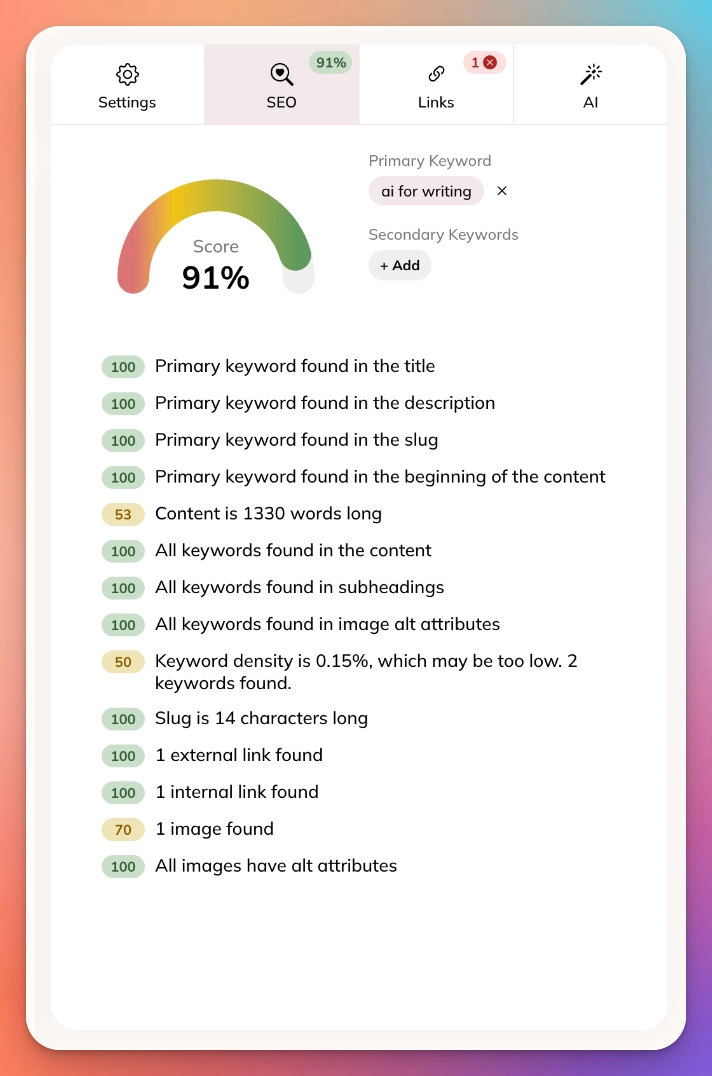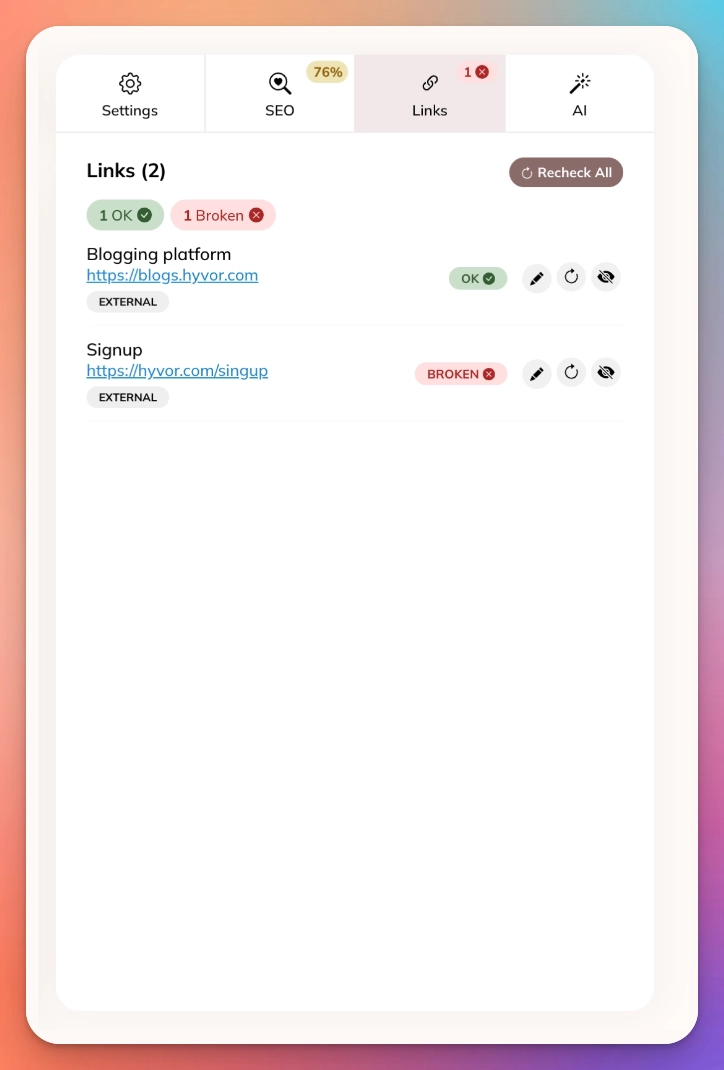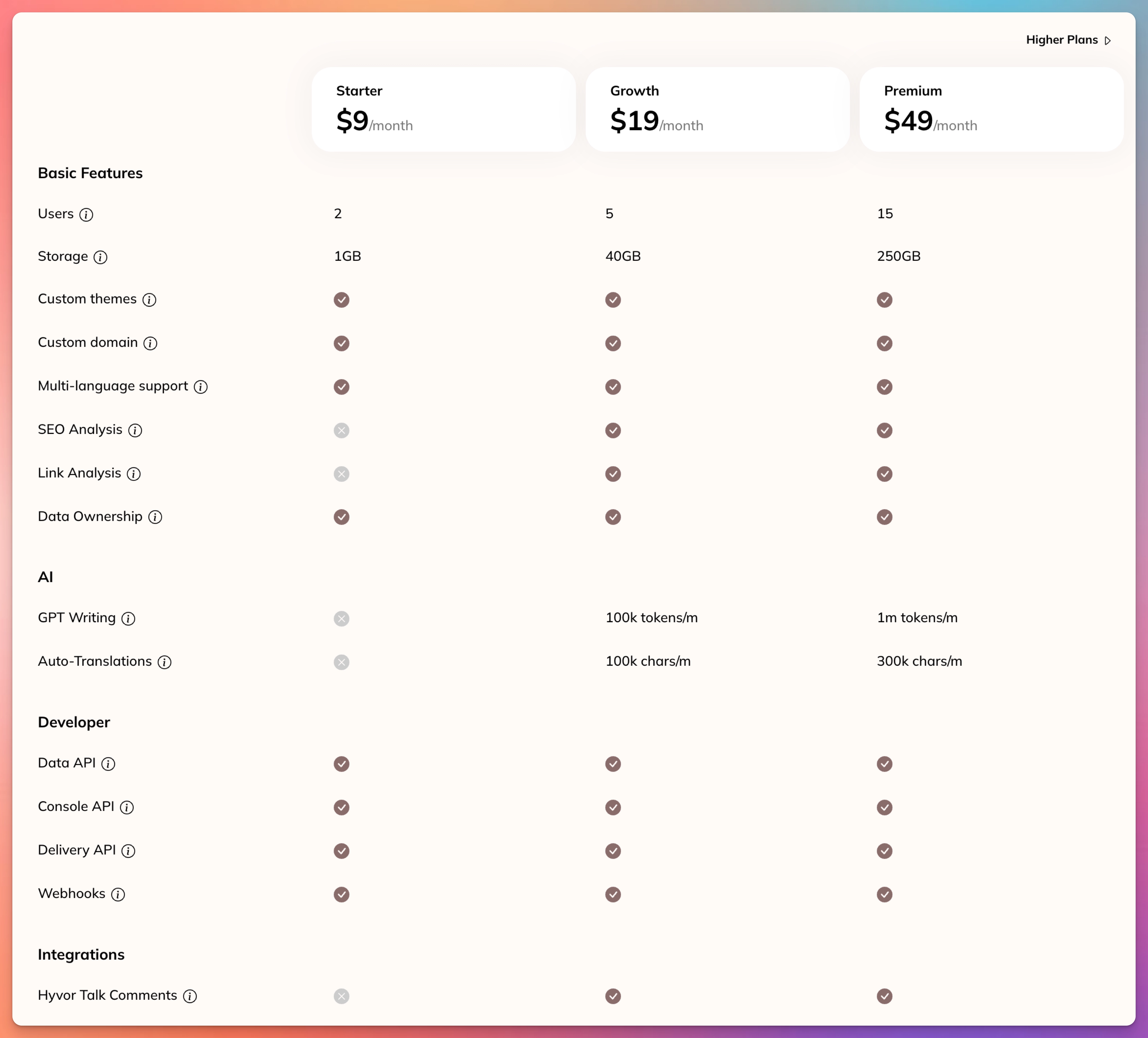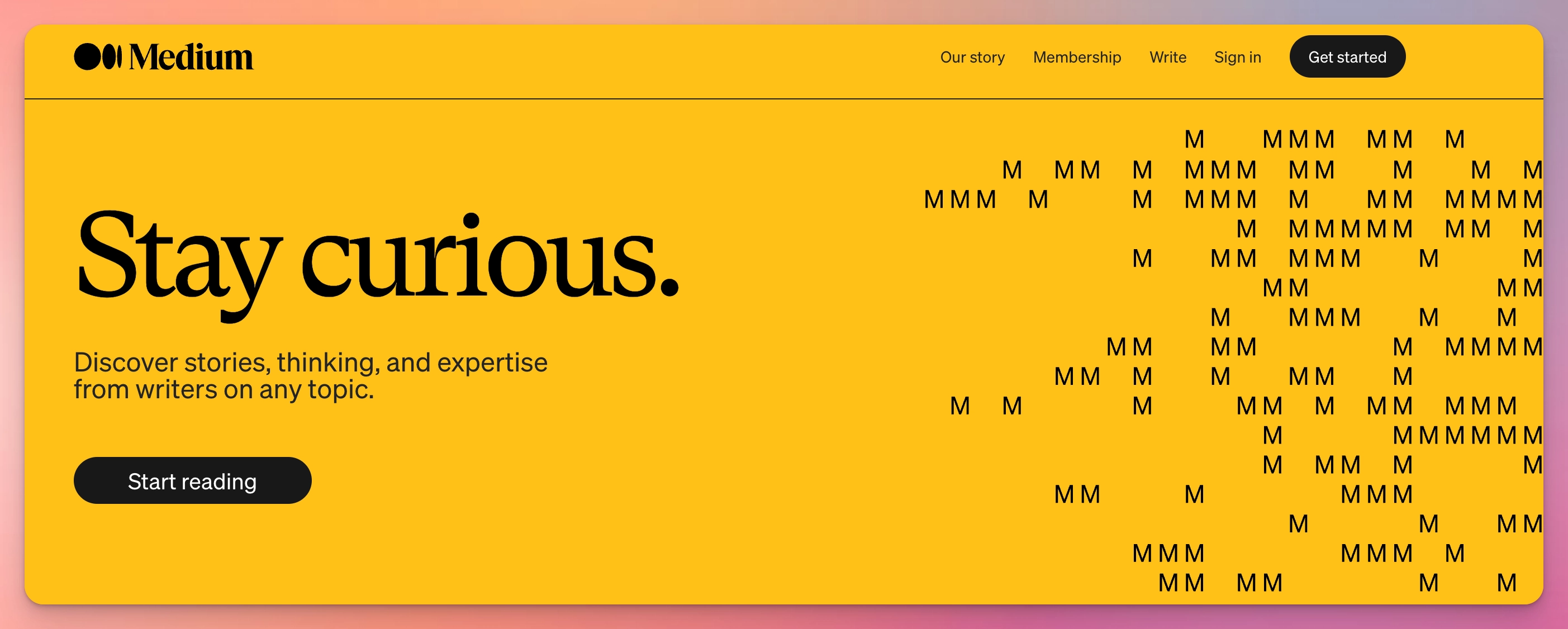Substack is a subscription platform that was founded in 2017. It gives you the space to create your own newsletter and publish content/posts independently. Not only that but also it allows you to start a paid subscription. FTR, Substack is known exclusively created for writers and content writers. However, Substack might not be the best choice for you according to your different blogging needs. Then, you have to look for Substack alternatives. In this article, we are going to see the 5 best substack alternatives in 2024 with a comprehensive explanation of how they become Substack alternatives.
Substack Alternatives
These are the substack alternatives we are going to explore in this article.
1. Hyvor Blogs
Hyvor Blogs is an all-in-one blogging platform. You can create a fully-featured blog with a custom theme, and host it on a custom domain with Hyvor Blogs. Here is a comparison between Hyvor Blogs and Substack. Hyvor Blogs is the best substack alternative if you want to focus on writing your own blog with your own domain and branding. Here are some of the key features of Hyvor Blogs.
Multi-language support by default - You can add new languages to your blog as you prefer. You can start multi-language blogging using different languages and grow your audience. It is just a piece of cake.
Auto translation - No tedious tasks of translating blog posts into different languages. With just one click, you can translate your blog posts easily.
Powerful rich text editor - Hyvor Blogs’s carefully crafted rich text editor makes writing blog posts effortless. Add headings, blockquotes, images, embeds, code blocks, and more.
Customizable Themes - Raydo, Pela, Zing, and more. All of these themes are editable and completely free for anyone using Hyvor Blogs. You can make your own theme for your blog if default themes do not satisfy you.
Custom domains
Right-to-left (RTL) languages supported
Free commenting system - Hyvor Talk is completely FREE in Hyvor Blogs. So you can have a comment space on your blog at no cost. A blog without a commenting space is dull.
Real-time SEO analysis - This real-time SEO analyzer gives you suggestions to improve your post's SEO as you write. It checks for keyword usage, internal and external links, and more SEO-related factors.
GPT (AI) for content creation - Chat with GPT to generate content, blog post outlines, and more. GPT is integrated directly into the editor, making it easy to use generated content in your posts.
Broken link analyzer - Hyvor Blogs’s link analyzer checks for broken links in your posts as you write. It also runs a bi-weekly check on all your posts and notifies you via email if any links are broken.
Mobile friendly - You can blog from anywhere using any device. Even using your mobile.
Google fonts, locally
Privacy protected
Complete control - HB does not inject ads, trackers, affiliate links, or paywalls into your blog. It's your blog - You decide everything!
Data Ownership - You own the content you write. You can export your content and move to another platform anytime.
In-built SEO - All you need for technical SEO is in-built in HB
Easy to set up with essential tools
Sub-directory hosting - Host your blog at /blog of your web app: Cloudflare workers, Next.js, Laravel, Symfony
Plus, Hyvor Blogs is completely developer-friendly.
Data API - Access public data of your blog as JSON using our Data API. For example, you can use it to get the latest posts on your blog. The Data API makes Hyvor Blogs work as a headless CMS for an alternative front-end.
Delivery API - Delivery API allows you to host your blog within a subdirectory of your web applications, with the help of Webhooks.
Console API - This is the same API we use in the Console. Automate some of your administrative tasks, or you can even build your own console.
Webhooks - Ping a URL when something happens on your blog (ex: when a post is created).
Not only that but also HB supports web framework integrations such as Symfony, Laravel, Cloudflare Workers, Next.js, etc.
Hyvor Blogs vs Substack
Feature | Hyvor Blogs | Substack |
|---|---|---|
Custom themes | ✅ (Beautiful in-built customizable themes for free or you can design themes yourself) | ❌ |
Blog Ownership | ✅ | ❌ |
Custom domain | ✅ | $50 fee |
Multi-language | ✅ | ❌ |
Rich text editor | ✅ | ❌ |
AI writing (GPT) for content creation | ✅ | ❌ |
In-built real-time SEO analysis | ✅ | ❌ |
In-built real-time link analysis | ✅ | ❌ |
APIs | ✅ | ❌ |
Membership & Subscriptions | ✅https://blogs.hyvor.com/docs/memberships | ✅ |
Multi-language supported and auto translations
Most of the blogs are available in English. But many people are not very comfortable with English. So it is a good move to do multi-language blogging when blogging because it increases your comfort audience. The other thing is not every blog is accessible for languages other than English. So choosing to make your blog multilingual is a good step toward improving your blog. In Substack, you cannot do that. The one and only thing that you can do in Substack is write posts in different languages.
In other words, that means if you have a particular post called “5 Best Substack Alternatives in 2024” written in English and you want to make it available in French, German, Spanish, Chinese, Japanese, and, Korean, you have to write the same post over and over again in those languages separately.
But in Hyvor Blogs, you can simply convert your written article into any language you want. With the AI-powered auto-translation feature, you can just translate your blog posts into different languages with just one click. You don’t have to write them in different languages again and again. Not only post but also you can convert everything in your blog into different languages with HB.
Custom Themes
In Substack, there are lots of limitations. You cannot customize the look of your newsletter much. But in Hyvor Blogs, there are a bunch of beautiful themes for you to choose from. These official blog themes are free and open-source: for example, “Zing“, “Pela”, “Hello”, “Raydo”, etc. The Hyvor Blogs team is working hard on introducing new themes as well. All official themes will forever be free. Therefore, you can easily switch between themes and find out the best one for you. And those themes can be customized as you prefer.
Not only that but also you can make your own themes and upload them into Hyvor Blogs and use them on your blog. A beautiful and attractive theme makes your blog visitors feel interested in spending time on your blog. On the other hand, Substack does not have that kind of theme or a feature that allows blog owners to create new themes. Besides, it has only one design which is its default design so you cannot make changes.
Here is the latest theme published “Raydo”. You can discover Hyvor Blogs’s themes here.
Custom Domains
In both Substack and Hyvor Blogs, you can use your own purchased domain. Rather than using the domain given by the platform it is way better and it is a good move; because when you use the domain given by the blogging platform that has its own domain in it (yourblogname.blogginplatformname.com), you are actually eventually improving its domain: NOT YOURS! So, using a custom domain from the very beginning is worth a lot. Because you own the whole success you gain from your efforts. You are improving your own domain. Not any others’. So we encourage you to use your own domain. But to use your own domain, Substack charges you an extra 50$ fee but Hyvor Blogs does not charge you any extra fee.
You own your blog
Hyvor Blogs does not own your blog. Moreover, your content and your whole blog are owned by you. Likewise, you have complete control over your blog.
Powerful blog console
Substack’s console is quite primary while HB’s console is much more than Substacks’s and it is user-friendliness makes it more special. You can control everything in your blog using that console. Moreover, you can manage the contributors/team of your blog via the Hyvor Blogs console. Also, in Substack team collaboration is possible but its nature is more like contributors/authors/writers.
In-built SEO Analyzer

Hyvor Blogs has a real-time SEO analyzer in the post editor to help you with on-page SEO. You know how SEO is important when you are running a blog right? Everything depends on SEO. Therefore you have to think about all SEO factors when creating content; that’s quite hard and you might miss things. That is why having such a feature is important. It will help you identify common issues and better optimize your blog posts for search engines.
In-built Link Analyzer

According to a study by Ahrefs, 66.5% of links become broken within 10 years. Broken links can significantly harm your blog’s user experience and SEO. This link analyzer analyzes all the links and lets you know their status. It consists of 2 separate features:
Link analysis: It gives real-time feedback for you as you write your post. This will help you publish your blog post without any broken links. This checks for internal, external, and even anchor links in your post.
Full blog link analysis - This does a bi-weekly (14 days) full-blog analysis checks for all links in your posts and provides you with a report via emails. Learn More.
AI (GPT) for content creation
Hyvor Blogs has integrated chat GPT 3.5 for you to easily generate content and add it to the editor.
You can generate content and use pre-built commonly used prompts such as SEO keyword ideas, FAQ generators, etc.
Google Fonts, Locally
With this, you do not have to deal with multiple CSS files, @font-face rules, uploading assets, etc. Or, you do not have to use a third-party service like Google Fonts, which comes with a privacy liability. This feature combines the simplicity of Google Fonts and the privacy of locally hosting the fonts. All the fonts (CSS and font files) are served directly from your domain - no requests are sent to Google or any other third party. Learn more.
Right-to-left (RTL) language supported
Hyvor Blogs explicitly support RTL languages like Arabic, Farzi, Hebrew, and more, etc. So if you are a blogger looking to blog using an RTL language or looking to run your blog in an RTL language, while it is already running on LTR language, Hyvor Blogs is the best choice for you. HB’s themes are also RTL language supported so you do not have to worry about that.
Powerful API
Hyvor Blogs has a powerful API but Substack does not.
No ads no interruptions
Not only that but also Hyvor Blogs does not run ads. Readers, visitors, and users of your blog don’t like any interruptions. So if you add interruptive ads, then it will cause a decrease in user engagement.
Social sharing
In addition, social sharing is available for every major social media in Hyvor Blogs. So, your users can share your content on social media with just a few clicks.
Built-in SEO
Moreover, when you write blog posts, you have to consider SEO. Therefore, you have to pay attention to keywords, slug, excerpt, meta description, etc. In HB you can control all of them but in Substack, the options you have gotten to control are fewer than in HB. And, not only that but also you can get support from the HB team if you are having any trouble. So does Substack.
Free Commenting System - Hyvor Talk
Similarly, Substack has its own in-built comments but in Hyvor Blogs, you can use commenting plugins like Hyvor Talk.
Easy to set up with essential tools
As a blogger, you may run ads, set up data collection forms, marketing tools, etc. For example, Google Adsense, Google Analytics, Typeform, Mailchimp, ConvertKit, Memberstack, etc. So, working with those tools is way too easier with Hyvor Blogs.
Here are our guides to essential tool integrations.
Hyvor Blogs is cheaper
Hyvor Blogs is not free, but it offers you a 7-day trial. And it has paid plans for you. However, Substack has a free plan and paid plans too. On the other hand apart from. the pricing plan you choose, there is nothing Hyvor Blogs cost you but Substack takes 10% of your revenue.
Hyvor Blogs pricing is based on the number of admin users (writers) on your blog and the total amount of Storage used. There are no feature limitations. See pricing for up-to-date information.

Starter Plan - $9/month
Growth Plan - $19/month
Premium - $49/month

Team Plan - $299/month
Business Plan - $699/month
Enterprise Plan - $1299/month
Note that you don’t have to pay for any of the features or themes.
Additionally…
Hyvor Blogs comes with in-built syntax highlighting with support for 100+ languages and 25+ Vscode themes. Line highlighting, focusing, numbering, and diff highlighting are supported out of the box. The minimum Subscription Fee required when using Substack is 5$ per month. If someone wants to read your newsletter, they have to pay that fee. This can be a significant barrier for the reader. But Hyvor Blogs does not charge any fee from your users.
2. Ghost

Ghost is an open-source blogging platform you bloggers to start blogging. This is also can be put in the Substack alternatives basket. Moreover, that was founded in 2013. It gives you the privilege to start your own blog in a few steps. However, Ghost does not have a free plan just as some other Substack alternatives do. But they offer you a 14-day free trial to try it. On the other hand, Substack is available at no cost to get started.
Rather than Substack Ghost has so many features that you might need to go on successfully with blogging. It lets you use custom domains. This means that you can use your own purchased domain for blogging. They do not charge an extra fee for that. Not only that but also in Ghost you can keep your revenue completely. They do not charge you a percentage for your revenue like in Substack. You can create your own email newsletter with Ghost. In addition, you can use custom email addresses in Ghost but not in Substack.
When it comes to creating and customizing your blog, getting started with Ghost is easy as same as in Substack. But Ghost gives you lots of options to customize your blog and build it in the exact way you want. But with Substack, you cannot do such a thing. Ghost has a powerful API while Substack does not have one.
The editor of Ghost is rich compared to Substack because Substack has a very basic editor. The console of the Ghost is much user friendly compared to Substack. The learning curve of Ghost is way better than Substack. Ghost has different custom designs for you to try on your blog. But Substack does not have it. It only has a default design that you cannot make any changes to. As Ghost is open source, you make the rules but in Substack, they control everything.
Substack is pretty expensive. However the Ghost platform costs $9 per month, but it’s free if you host it yourself on your own servers. Of course, you must pay for your own hosting, but many people already have it and may easily add another website for free. If Ghost doesn’t sound right to you, then you can look for Ghost alternatives.
3. Medium

This is the third Substack alternative on our list which is quite similar to Substack. It is mainly a publishing platform where you can publish your content and maintain a blog or something like a newsletter.
Medium is free same as Substack and it is easy to get started with. Medium has a paid plan with unlimited access but for a beginner that might not be a good choice. However, beginners can use Medium for free easily. Medium has ads and annoying popups while Substack does not have ads. If you already have some great unique content and all you want is to rank them on the internet then Medium is a good choice for you because you cannot do that quickly with Substack. In other words, getting traction is easy in Medium rather than Substack because Medium has a very big audience.
Medium has two subscription options. One is a $5/month membership that allows you to read an infinite number of articles on the platform. The other one is a $5/month membership that allows you to read an unlimited number of articles on Medium. The Medium Partner Program may be able to assist you in earning money through writing. You earn money when someone who is a Medium member reads your Metered Paywall piece. A portion of the $5 goes to the writers, while the rest goes to the Medium Company.
In Medium it is easy to categorize articles to ensure they are found and the change tracker helps review changes before the article is published.
In Medium you will not find custom themes but a standard one and only the default Medium design. Apart from that, there is no other design in Medium. So do Substack. However. you can do very limited customization on it. If you are looking to run a minimalist blog, then go with Medium as a Substack alternative.
Medium lets you use custom domains for your blog. But both Substack and Medium give you a subdomain for free and hosting for free. But if you want to use a custom domain in Substack you have to pay them an extra fee. On the other hand, Medium is best for people who want to share their knowledge, ideas, and expertise in any topic with a huge amount of audience online. As Substack and Medium, are not open source, you do not own your blogs, they own them. They can take down your blogs whenever they want. That is a big drawback that both these platforms have. If you feel that Medium does not ring for you then go to the rest of the article or look for Medium alternatives.
4. Patreon
This is the 4th Substack alternative that we are listing in this article. Patreon is a well-known Substack alternative that was founded in 2013. The key distinction between Substack and Patreon is that Substack is a platform that allows creators/writers to publish their own newsletters. Patreon is a website that offers business tools to content creators and is funded by subscriptions.
Substack only focuses on writers and podcasters, while Patreon offers room for all kinds of creators. While Substack has a simple style and setup, Patreon includes a page where users and followers may get ad-free material, exclusive uploads, and early access to new projects.
Patreon, in comparison to Substack, places a greater emphasis on recurring memberships with multiple tiers. Patreon is a less laid-back but potentially more lucrative choice than Substack because it focuses more on committing to different types of content for different tier levels. Furthermore, Patreon’s capabilities apply to all types of content creators (not just writing and podcasting). Patreon is likely to be a better alternative for you than Substack if you want to seriously push a recurring membership with different tiers to your audience.
Creators can choose from three different Patreon options, all of which feature no monthly fees or sign-up costs. Instead, Patreon will take 5% to 12% of your monthly income, plus any usual payment processing fees. Patreon analytics contain information about your Patreon page, postings, income, number of patrons, and income growth, among other things. Google Analytics integration is also available through Patreon.
Substack is the greatest option if you’re looking to make money by composing and sharing newsletters. Patreon is the greatest option if you want to share and create material in addition to writing. Patreon connects with its users through a feed, much like Facebook and Instagram.
They have three different pricing plans which have different features in them called Lite Pro, Premium starting from 5$. Patreon also gives you a free subdomain and a chance to use your own domain.
5. Tumblr

This is also can be recognized as one of the Substack alternatives. Tumblr is a microblogging and social networking website that was started in 2007 by David Karp and is now owned by Automattic. Users can submit multimedia and other content to a short-form blog using the service. People can read the blogs of other users. Bloggers have the option of making their blogs private.
Tumblr is free to get started with: of course, it is free to set up an account on Tumblr. And as you open an account on Tumblr all you have to do is follow a very simple set of steps to set up your blog. As I said earlier, Tumblr is more like social media. So if you do not want a typical type of blog then you can use Tumblr.
As same as Substack, Tumblr also has security issues. You do not own your blog on Tumblr and you are not the only one who has control over your blog; Tumblr has it. So if you are concerned about privacy and security then neither Tumblr nor Substack is a good choice for you.
On Tumblr, more than one person cannot contribute when blogging. However, in Substack, multiple people can contribute to your blog. So if you are a beginner having yourself as the one and only author or you do not team contribution when blogging, just go with Tumblr. If not go with Substack. On Tumblr, you can visit other blogs and leave your ideas on their content and get ideas from their work.
Your blog users can reshare/repost your blog posts on Tumblr. Not only that but also users can react to your content too. Tumblr is ideal for creating bite-sized pieces of content like infographics, quotes, and photos rather than long-form content. So, Substack is ideal for making blogs, and newsletters with long-form content. So if you are doing a blog for a hobby then Tumblr is a good alternative for you. Or if you want to blog more like social media, then Tumblr is the ideal choice for you.
On Tumblr, there are several pre-designed themes and you can customize them using CSS and HTML. But Substack does not have customer themes. It only has a default design that you cannot do customizations.
However, see your goals, purposes, and requirements for blogging and then choose Tumblr or any other Substack alternative because choosing an alternative depends on your needs and requirements for blogging. If you feel that Tumblr does not ring for you then go to the rest of the article or look for Tumblr alternatives.
At Last…
In blogging, we all come across choosing a good blogging platform. However, your favorite blogging platform may not fulfill your blogging purposes. Then we have to look into the alternatives. In this case Substack alternatives. We hope that you got a better idea about Substack alternatives. And why they become alternatives to Substack for you. If you have comments, questions, and suggestions, please comment down below. Happy Blogging!

Comments